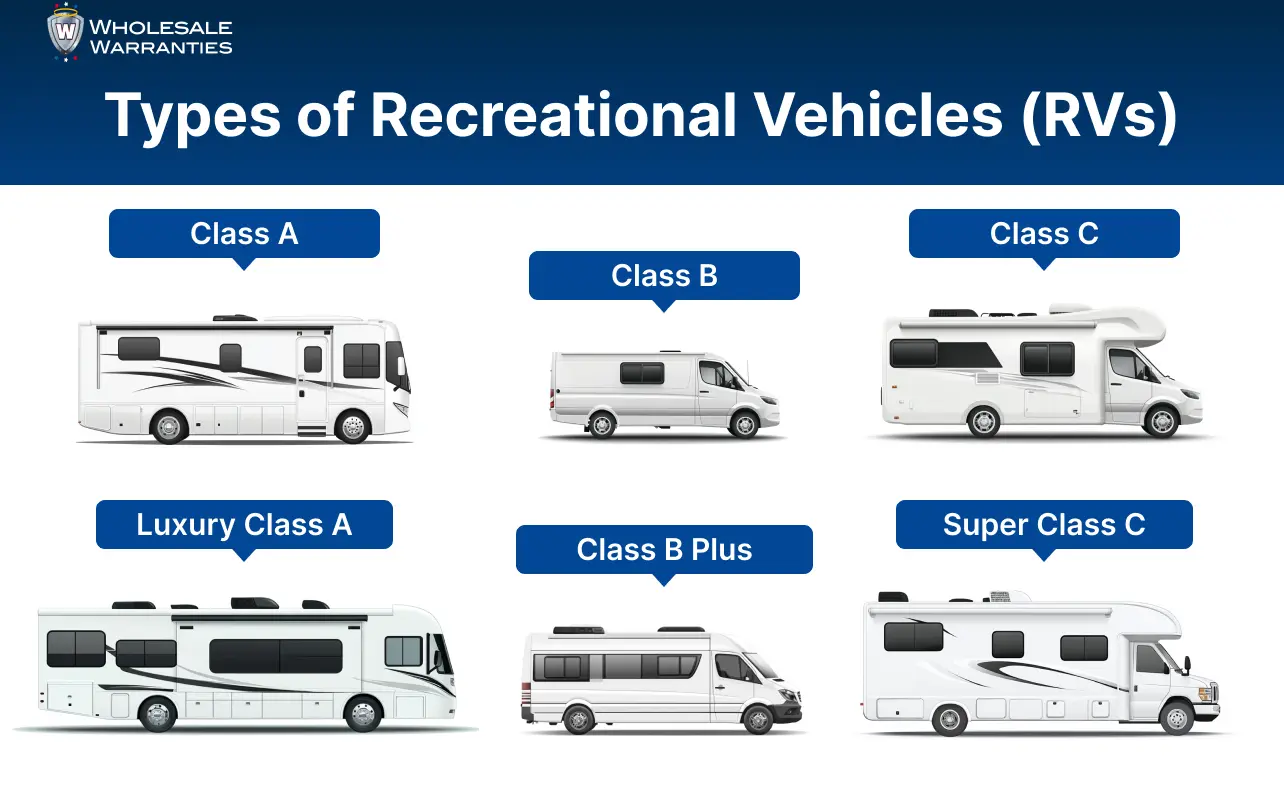Let’s face it – there’s something magical about hitting the open road with your bed, kitchen, and bathroom all rolling along behind (or beneath) you. I fell in love with RV travel during a cross-country trip with my parents as a kid, and the lifestyle has only gotten more appealing since. With so many different types of RVs available today, there’s truly something for every traveler and budget.
From tiny teardrop trailers that barely fit a mattress to massive luxury motorhomes that make apartments look cramped, the RV world has exploded with options. Whether you’re dreaming of weekend escapes to national parks or selling everything to become a digital nomad, finding the right RV can make or break your adventure.
I’ve spent years talking to full-timers, weekend warriors, and reluctant spouses who were eventually converted to the RV lifestyle. One thing they all agree on: choosing the right type of RV for YOUR specific needs matters more than what’s trending on Instagram. So let’s break down what’s actually out there, with all the real-world pros and cons that brochures won’t tell you about.
In this guide, we’ll break down the most common types of RVs: Class A, Luxury Class A, Class B, Class B Plus, Class C, and Super C motorhomes.
Class A Motorhomes: The Classic Big Rig
When most people think of a motorhome, a Class A RV is what comes to mind. Built on a heavy-duty chassis—often a commercial truck or bus frame—Class A motorhomes are the largest and most spacious drivable RVs on the market.
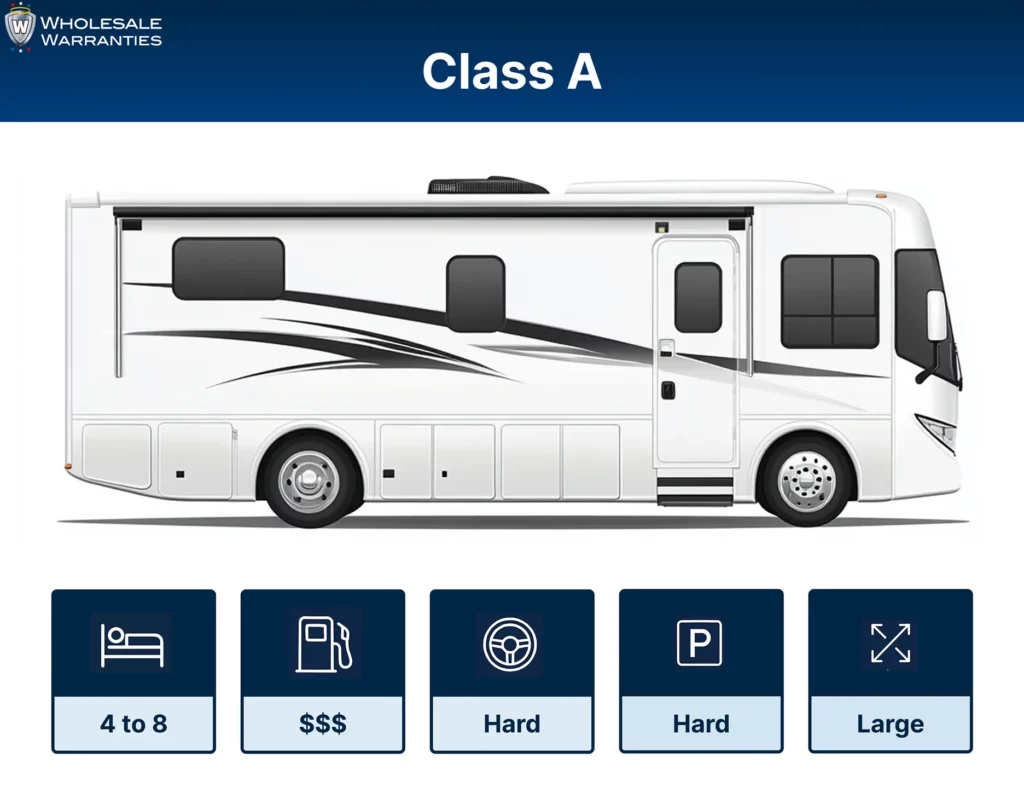
Key Features of Class A RVs:
- Size: Typically 26 to 45 feet long
- Sleeping capacity: 4–8 people
- Amenities: Full-size kitchens, large bathrooms, separate bedrooms, multiple slide-outs
- Ideal for: Long-term travel, full-time RV living, large families
Interior Features & Living Comfort
Class A RVs often feel like luxury apartments, featuring:
- Full kitchens with convection ovens and full-size fridges
- Private bedrooms with queen or king beds
- Bathrooms with real showers, some have 1.5–2 baths
- Entertainment systems, including 40–60″ TVs, surround sound
- Washer/dryer units, fireplaces, recliners, and even tile floors
Construction & Chassis
Class A RVs are built on a heavy-duty chassis, either:
- Gasoline-powered (Ford F-53 is common)
- Diesel-powered (diesel “pushers” have engines in the rear for better ride quality and torque)
They range from 26 to 45 feet in length and are designed for maximum living space, often with multiple slide-outs.
Average Cost of Class A Motorhomes
The cost of a Class A motorhome depends heavily on size, brand, engine type, and luxury features:
| Type | Price Range |
| Entry-Level Gas | $90,000 – $150,000 |
| Mid-Range Gas | $150,000 – $250,000 |
| Diesel Class A | $200,000 – $500,000+ |
| Luxury Diesel Pushers | $500,000 – $1,000,000+ |
Popular brands include Tiffin, Newmar, Fleetwood, Thor, and Entegra.
Maintenance & Operating Costs
Maintenance Considerations:
- Engine/Chassis: Oil changes for diesel engines can run $200–400; gas is a bit cheaper
- Tires: 6–8 large tires, $400–800 each; lifespan ~5–7 years
- Slide-outs: Regular lubrication and seal checks
- Roof/Seals: Needs annual inspection to prevent leaks
For more information on RV costs, check out our article on the most common RV breakdowns.
Estimated Annual Costs:
| Item | Estimated Cost (Annually) |
| Fuel | $3,000–$7,000 (depends on mileage) |
| Insurance | $1,200–$2,500 |
| Maintenance & Repairs | $1,000–$5,000+ |
| Storage (if applicable) | $500–$2,000 |
Pros:
Generally, Class A motorhomes have the following pros:
- Luxurious interior space
- High storage capacity (both inside and in exterior bays)
- Can include residential appliances and large entertainment systems
Cons:
Generally, Class A motorhomes have the following cons:
- Difficult to drive and park due to size
- Lower fuel efficiency
- Can be costly to maintain and insure
Luxury Class A Motorhomes: First-Class RV Travel
Luxury Class A RVs are an upgraded category within the Class A family, offering high-end features, craftsmanship, and technology. These motorhomes are typically diesel pushers, meaning they have rear-mounted diesel engines for smoother, quieter rides and better torque.
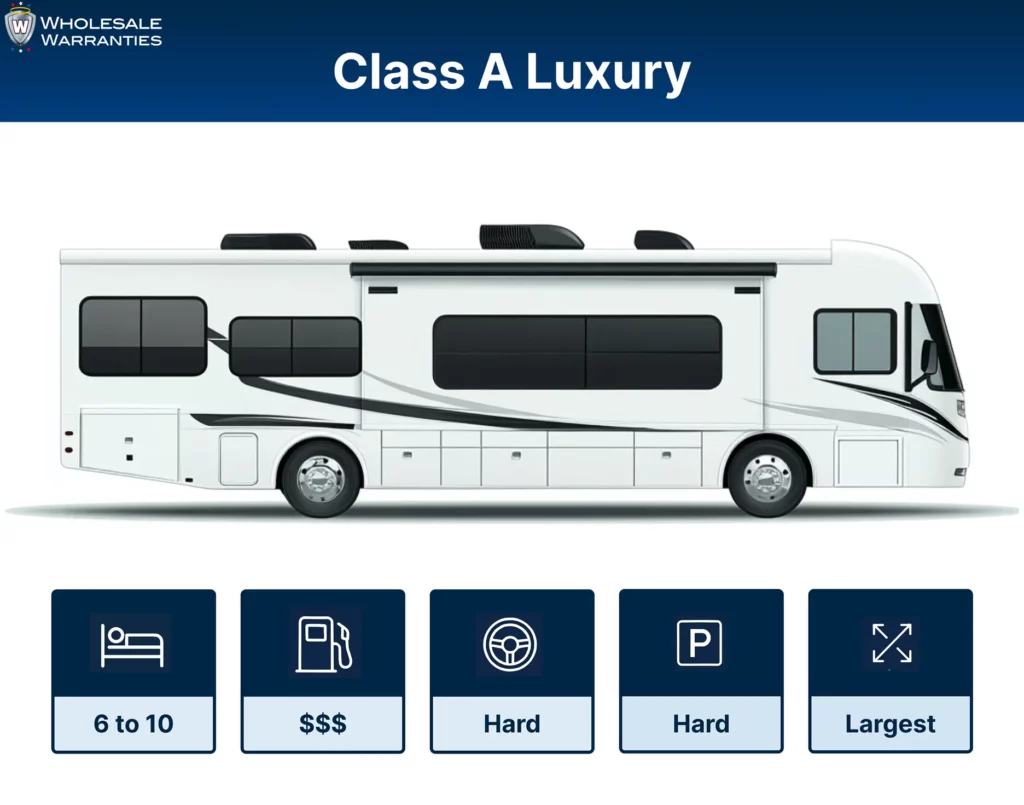
Luxury Features May Include:
- Tile flooring, marble countertops, and high-end furnishings
- Full-size residential kitchens with premium appliances
- King-size beds, washer/dryers, and multiple bathrooms
- Smart home automation and high-end audio/visual systems
Who It’s For:
- Luxury travelers
- Retirees spending extended time on the road
- Full-time RVers who want a residential feel
Luxury Class A RVs truly offer a five-star experience wherever you go. However, the increase in luxury comes at a price. On average, a Luxury Class A motorhome is $250,000 to $500,000+ more expensive than a standard or mid-range Class A gas model.
Class B Motorhomes: Compact and Efficient
Often referred to as camper vans, Class B motorhomes are built on a standard van chassis and are the smallest of the motorhome categories. Despite their compact size, many Class B RVs are cleverly designed to include essential amenities like a kitchenette, wet bath, and convertible sleeping areas.
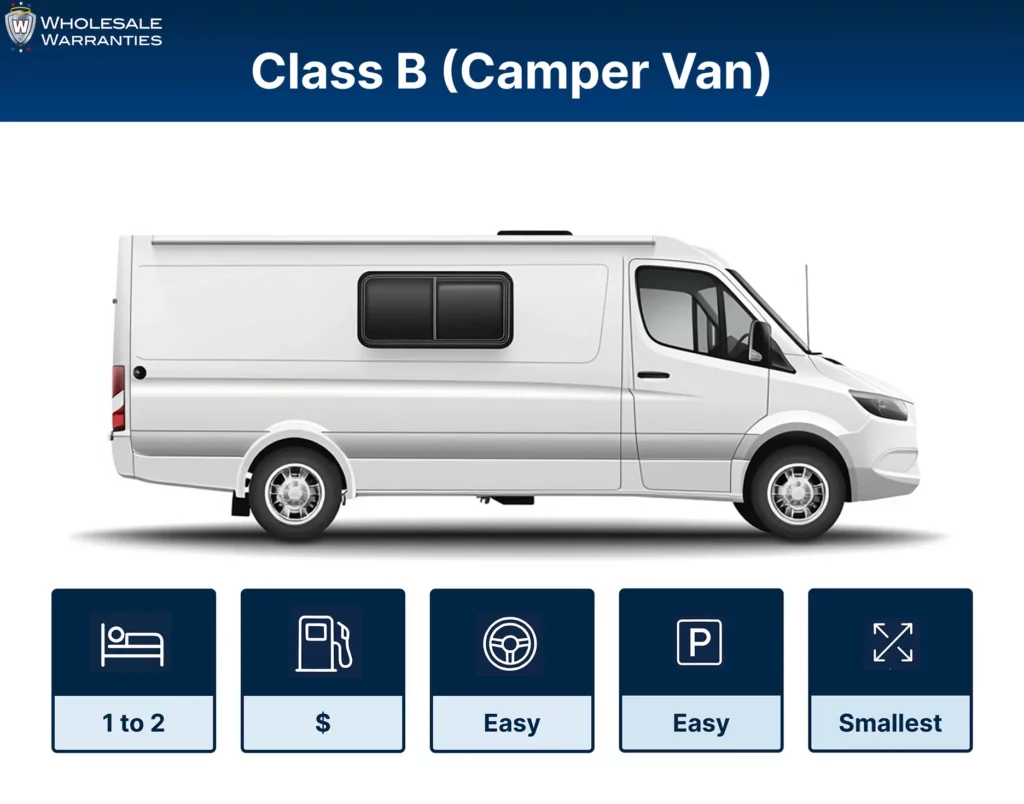
Key Features of Class B RVs:
- Size: 17 to 24 feet
- Sleeping capacity: 1–2 people
- Fuel efficiency: Best among motorhomes
- Maneuverability: Easy to drive and park, even in cities
Interior Features & Living Comfort
While compact, Class B interiors are designed for maximum efficiency. Most include:
- Convertible bed/sofa or platform bed
- Small kitchen (induction or propane cooktop, sink, fridge)
- Wet bath or cassette toilet
- Swivel front seats for lounge/dining area
- Fold-out tables or indoor/outdoor workspaces
Some high-end models offer:
- Air suspension for smoother rides
- Touchscreen control panels
- Heated floors or tanks for winter use
Construction & Chassis
Class B motorhomes are built on full-size van chassis, like the Mercedes-Benz Sprinter, Ford Transit, or Ram ProMaster. The van body stays mostly intact, making these RVs easy to drive and park.
- Length: 17–24 feet
- Fuel: Gas or diesel
- Drive options: FWD, RWD, or AWD
Their compact, all-in-one design means no slide-outs and quick setup—perfect for solo travelers, couples, or anyone wanting a nimble, go-anywhere RV.
Average Cost of Class B Motorhomes
Class B motorhomes are compact but often come with high-quality materials and features, making them one of the most expensive RVs per square foot.
| Type | Price Range |
| Entry-Level Gas Models | $80,000 – $120,000 |
| Mid-Range Builds | $120,000 – $180,000 |
| Diesel Models | $160,000 – $250,000+ |
| Luxury Class B Vans | $250,000 – $350,000+ |
Factors that affect cost include the base chassis (Sprinter vans are pricier), off-grid upgrades (solar/lithium), and premium interiors. Brands like Airstream, Winnebago, and Pleasure-Way tend to sit at the higher end.
Maintenance & Operating Costs
Because they’re based on commercial vans, Class B RVs are easier and cheaper to maintain than larger RVs.
Maintenance Overview:
- Oil changes: ~$100–150 (diesel can be higher)
- Tires: ~$150–250 each; typically 4 tires
- Systems: Keep an eye on seals, appliances, and water systems
Estimated Annual Costs:
| Item | Estimated Cost (Annually) |
| Fuel | $1,200–$3,000 |
| Insurance | $800–$2,000 |
| Maintenance | $500–$1,500 |
| Storage (if needed) | $0–$1,000 |
Many Class B owners avoid storage costs by using it as a daily driver or second vehicle.
Pros:
Generally, Class B motorhomes have the following pros:
- Great gas mileage
- Fits in standard parking spaces
- Ideal for solo travelers or couples
Cons:
Generally, Class B motorhomes have the following cons:
- Limited storage and living space
- Smaller tanks and appliances
- Not ideal for large families
Class B RVs are perfect for weekend warriors, digital nomads, and minimalist travelers who want flexibility and freedom.
Class B Plus Motorhomes: A Roomier Alternative
Class B Plus RVs bridge the gap between Class B and Class C. Though not an official designation, the term “B+” is used by manufacturers to describe slightly larger vans with more interior space, no over-cab sleeping area, and often upgraded interiors.
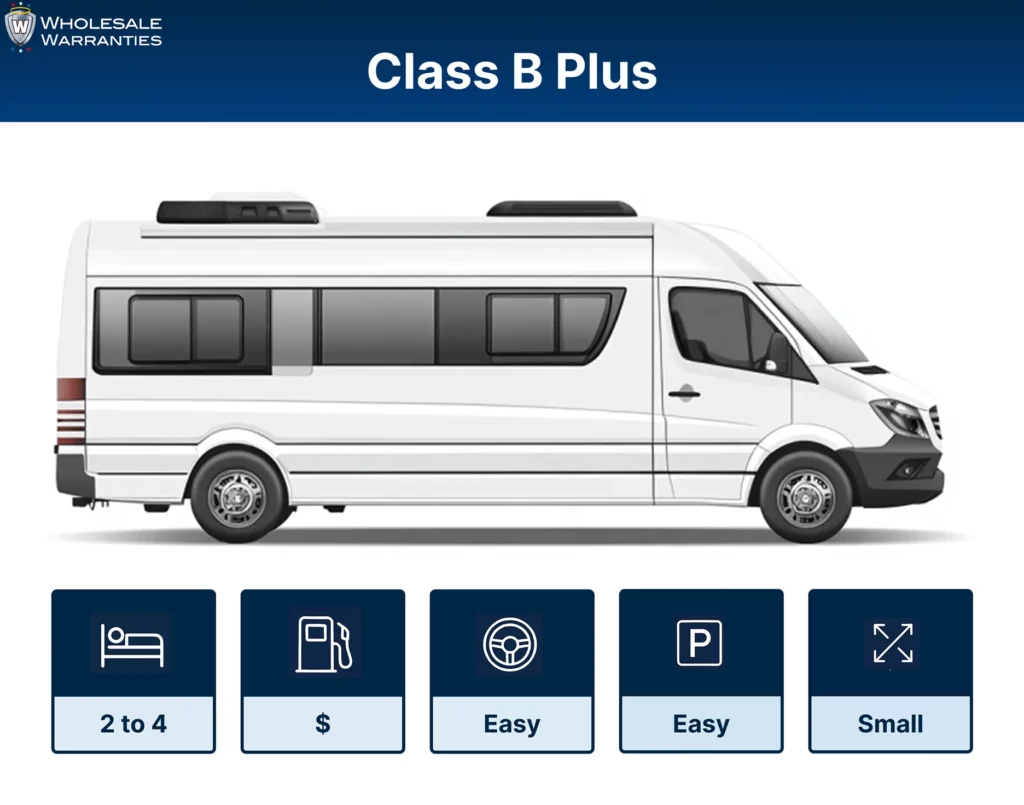
Key Features:
- Size: 22 to 28 feet
- Sleeping capacity: 2–4 people
- More storage and room than Class B
- Often includes dry bathrooms (separate shower/toilet)
Pros:
- More spacious without being too large
- Easier to drive than Class C or A
- Stylish, modern interiors
Cons:
- Pricier than Class B
- Still compact compared to Class C or A
Class B Plus RVs are ideal for travelers who want a bit more comfort and space without stepping into full Class C territory.
Class C Motorhomes: Family-Friendly and Functional
Class C motorhomes are easily recognizable by their over-cab sleeping or storage area. Built on a truck or van chassis, they combine the convenience of a smaller vehicle with the space and amenities of a larger RV.
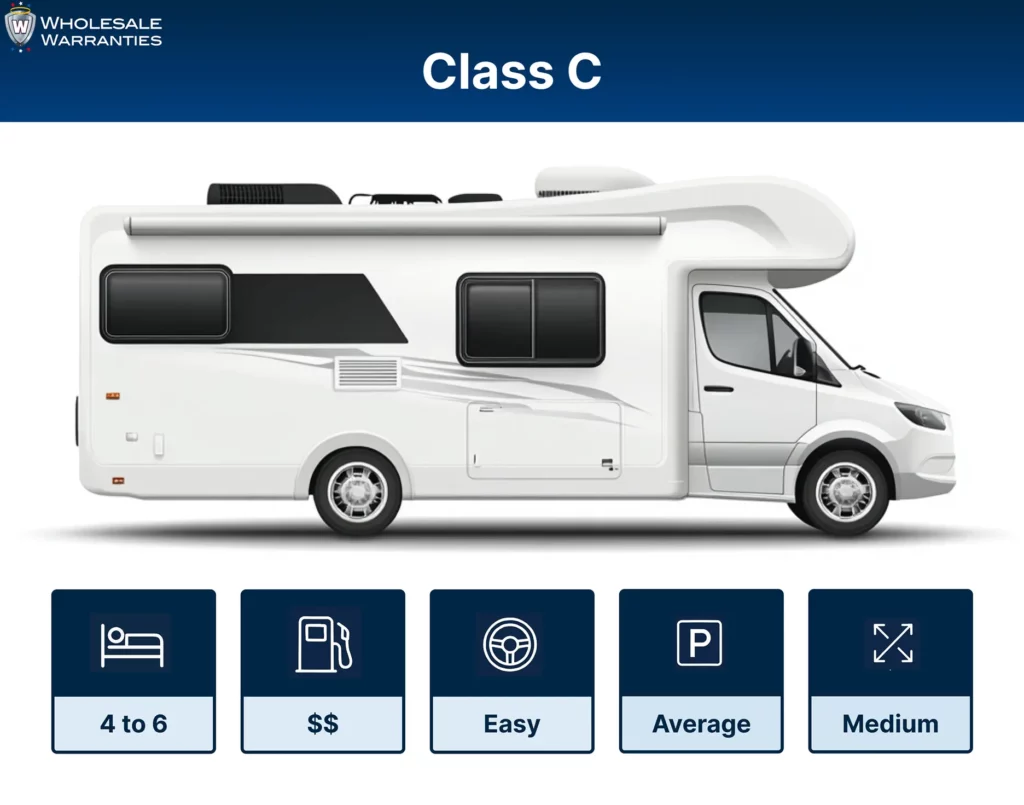
Key Features of Class C RVs:
- Size: 20 to 33 feet
- Sleeping capacity: 4–6 people
- Layout: Separate bedroom, full kitchen and bathroom, dinette, and over-cab bunk
- Towing: Many can tow a small vehicle or trailer
Interior Features & Living Comfort
Class C motorhomes are known for their smart, family-friendly layouts. Most models include a private bedroom, over-cab bunk, full kitchen, and a separate bathroom—all packed into a mid-size frame. Common features include:
- Queen bed, convertible dinette or sofa beds
- Full kitchen with microwave, stovetop, fridge
- Overhead storage and wardrobes
- Dry bath (separate toilet and shower)
- Entertainment system with TV/DVD
With space for up to 6–8 people, Class C RVs are ideal for families or small groups who want residential comfort without the size or cost of a Class A.
Construction & Chassis
Class C motorhomes are built on a truck or van cutaway chassis, commonly using Ford E-Series, Chevy Express, or Mercedes Sprinter platforms. They’re easily recognized by the over-cab bunk area and offer a nice balance between space and drivability.
- Length: 20–33 feet
- Fuel: Gas or diesel
- Drive type: Rear-wheel drive (AWD available in newer models)
With their familiar cab style and mid-range size, Class C RVs is a great option for families and first-time RVers.
Average Cost of Class C Motorhomes
Class C RVs offer a great mix of comfort, space, and value, making them one of the most popular motorhome types.
| Type | Price Range |
| Entry-Level Gas Models | $90,000 – $130,000 |
| Mid-Range Gas Models | $130,000 – $180,000 |
| Diesel Class C Models | $170,000 – $250,000+ |
| Super C (Heavy-Duty Diesel) | $250,000 – $500,000+ |
Costs vary based on chassis type, interior features, slide-outs, and whether it’s a standard Class C or a Super C designed for heavier towing and more luxury.
Maintenance & Operating Costs
Class C motorhomes are generally more affordable to maintain than Class A rigs, thanks to their familiar truck-based chassis and more accessible components.
Estimated Annual Costs:
| Item | Estimated Range |
| Fuel | $2,000 – $5,000 |
| Insurance | $1,000 – $2,000 |
| Routine Maintenance | $500 – $1,500 |
| Tires (every ~5 years) | $150–300 each (6 tires) |
| Storage (if needed) | $500 – $1,500 |
Maintenance includes oil changes, tire care, brake checks, slide-out servicing, and roof/seal inspections. Diesel models and Super C RVs tend to have higher costs due to specialized parts and larger engines.
Pros:
Generally, Class C motorhomes have the following pros:
- Great for families and groups
- Easier to drive than Class A
- Generally more affordable
Cons:
Generally, Class C motorhomes have the following cons:
- Can feel cramped with larger groups
- Over-cab area can limit aerodynamics
Class C RVs are a solid all-around option for families, first-time RVers, or anyone looking for a versatile travel setup.
Super C Motorhomes: Power Meets Luxury
Super C RVs are a high-performance upgrade of the Class C. Built on a heavy-duty truck chassis (like a Freightliner), Super C RVs offer more power, better towing capacity, and extra durability—often rivaling or surpassing Class A features.
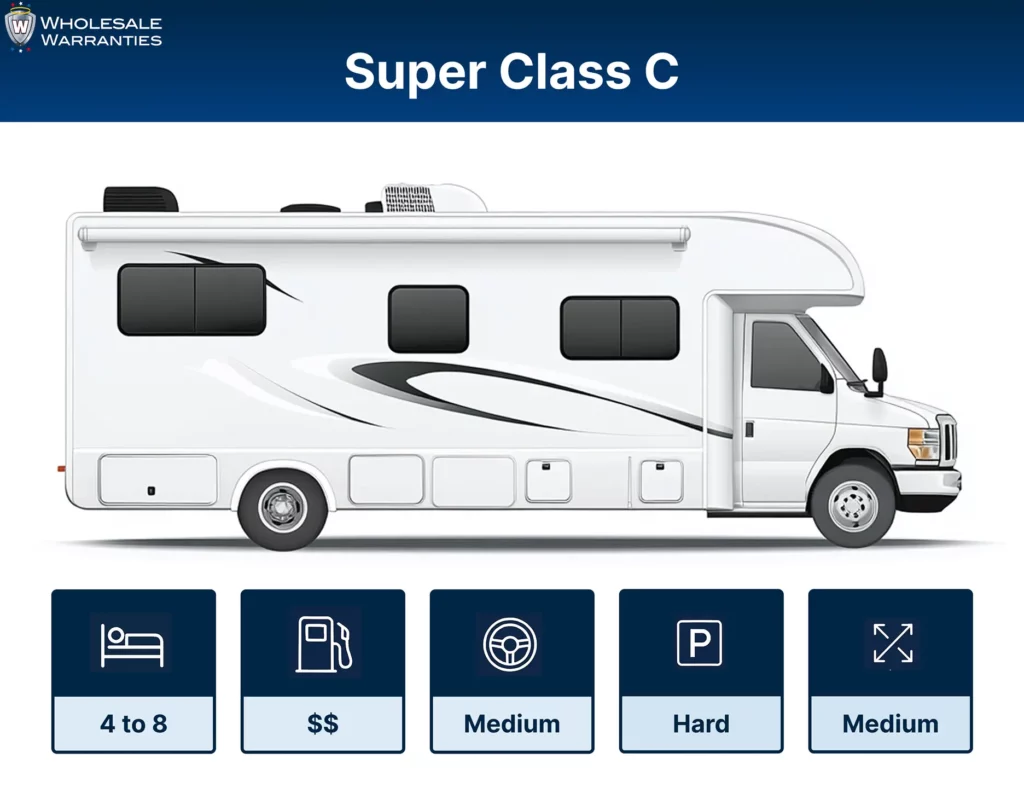
Key Features of Super C RVs:
- Size: 30 to 45 feet
- Power: Diesel engine with high torque
- Capacity: Can tow large trailers, cars, boats
- Interior: Often luxurious, similar to Class A
Pros:
- Incredible towing capability
- Safer cab with better driver protection
- Spacious and comfortable
Cons:
- More expensive than standard Class C
- Larger and heavier, needs a powerful engine
Super C RVs are ideal for travelers who want Class A comfort with the power and durability of a commercial truck chassis.
Choosing the Right RV Class for You
When comparing the different types of RVs, it all comes down to your travel goals, budget, and lifestyle. Here’s a quick guide to help you decide:
Quick Comparison
| Feature | Class A | Class B | Class C |
| Size | Largest | Smallest | Medium |
| Drive Ease | Hardest | Easiest | Moderate |
| Fuel | Least efficient | Most efficient | Moderate |
| Luxury | High-end | Basic to modern | Mid-range |
| Best For | Full-time RVers | Solo/couple travel | Families, mid-term trips |
Size Comparison
| RV Class | Best For | Size Range | Sleeps |
| Class A | Full-time luxury living | 26–45 ft | 4–8 |
| Luxury Class A | High-end, long-term travelers | 35–45+ ft | 4–8+ |
| Class B | Solo/couple short trips | 17–24 ft | 1–3 |
| Class B Plus | Small families, more comfort | 22–28 ft | 2–4 |
| Class C | Families or first-timers | 20–33 ft | 4–8 |
| Super C | Power + comfort combo | 30–45 ft | 4–8 |
Comparison of the “Plus” & “Super” Upgrades
| Term | Base Class | What It Really Means |
| Super C | Class C | Bigger, stronger, more luxurious version of a Class C |
| Class B+ | Class B/C | Hybrid between Class B and C—roomier, more amenities |
| Luxury A | Class A | Top-tier Class A with premium features (tag axles, tile floors, etc.) |
Consider Investing in an RV Extended Warranty
RV extended warranties are a great way to preserve the integrity of your motorhome without being put out with unforeseen costs. At Wholesale Warranties, we understand the unique needs of RV owners. With reliable RV extended warranties customized for you, we’re here to make your adventures easy, memorable, and stress-free. Get a quote for an extended RV warranty today.
Final Thoughts on the Different Types of RVs
Whether you’re looking for a nimble camper van for weekend getaways or a spacious motorhome for full-time life on the road, understanding the different types of RVs helps you make a confident choice. Each RV class has its strengths, and there’s truly an option for every kind of traveler. For more information on different types of RVs, check out our comparison of the RV classes.
Ready to explore the RV lifestyle? Start by touring different models in person or renting various classes to find the perfect fit.
FAQs About Different Types of RVs
What is the difference between Class B+ and Class C motorhomes?
Class B+ motorhomes are essentially larger Class B vans, with more interior space and no over-cab sleeping area. They offer more comfort than a standard Class B but are still smaller than a Class C. Class C motorhomes, on the other hand, are built on a truck chassis with an over-cab sleeping area, providing more space and features, such as multiple beds, larger kitchens, and separate bathrooms. Class B+ is a great middle ground if you want more space than a Class B but don’t need the size and weight of a Class C.
Which RV is the cheapest to travel with?
Class B motorhomes are generally the cheapest to travel with due to their fuel efficiency (14–22 MPG), smaller size(which reduces tolls and parking fees), and lower maintenance costs. They’re built on van chassis, making them easier to maintain and park, especially in cities. While the initial purchase price of a Class B can be higher per square foot, they save money over time in terms of fuel and upkeep, making them the most affordable RV for frequent travelers.
What are the benefits of a Class A motorhome?
Class A motorhomes are the largest and most luxurious, offering spacious interiors, full-sized appliances, and top-of-the-line amenities. They are ideal for long-term travel or full-time RV living, as they often include multiple slide-outs, king-sized beds, and expansive living spaces. While they are expensive to buy and operate, they provide unmatched comfort for those who want to live on the road in luxury.
Which RV is best for families?
Class C motorhomes are generally the best choice for families due to their family-friendly design, ample sleeping capacity, and affordable price compared to Class A. They have over-cab bunk areas, separate bedrooms, and larger living spaces, making them perfect for traveling with children. Class B+ models are also an option for smaller families, providing more space than a Class B but still keeping the cost and fuel efficiency lower than a Class C.
Are Luxury Class A motorhomes worth the price?
Luxury Class A motorhomes are designed for those who want the highest level of comfort and amenities while traveling. These RVs often include premium finishes, residential-grade appliances, and high-tech features. If you’re planning on full-time RV living or want a high-end experience on the road, a Luxury Class A might be worth the investment. However, they come with a significant price tag, and maintenance costs can be high, so they are best for those who prioritize luxury and comfort.
What is a Super C motorhome?
A Super C motorhome is an upgraded version of a Class C RV, built on a heavy-duty truck chassis for better towing capacity and durability. Super C RVs offer more power, luxury features, and the ability to haul heavier loads compared to standard Class C models. They’re perfect for large families, those who need heavy-duty towing, or full-time RVers who want a more powerful and luxurious motorhome.
Which RV is easiest to drive?
Class B motorhomes are the easiest to drive, thanks to their compact size and van-like handling. They can easily fit into regular parking spaces and are great for navigating narrow streets or urban areas. Class C RVs are also relatively easy to drive, with a familiar truck cab, but they can be bulkier, especially if you opt for models with slide-outs. Class A RVs, due to their large size, can be challenging for first-time RV drivers.

